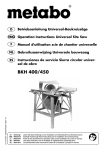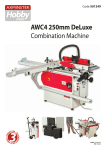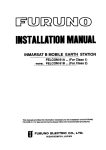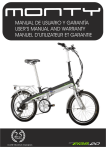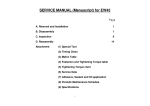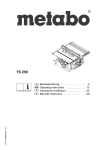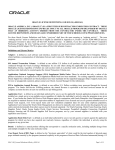Download Metabo BKS 400 Operating instructions
Transcript
Assembly/Operating Instructions Site Saw BKS 400/BKS 450 Model No. 1001 3305 Stock-no. 115 107 8059 Contents 1.0 2.0 3.0 4.0 5.0 6.0 7.0 8.0 9.0 10.0 11.0 12.0 13.0 14.0 15.0 16.0 Scope of Application Specifications User Responsibility Standard Accessories Optional Accessories Assembly Mitre Fence Assembly Installation Operation/Settings Cutting Saw Dust Collection (optional accessory) Crane Lifting Safety Rules Care and Maintenance Wiring Diagrams Spare Parts List and Drawing 1.0 Scope of Application - This site saw model BKS 400/BKS 450 has been designed to perform rip and cross cuts in wood having a square or rectangular cross section. - Cross cuts should only be performed with the help of the mitre fence. - Round stock or firewood should not be cut without an appropiate jig holding the work safely. - The maximum/minimum blade diameters are 400/350 mm for model BKS 400 and 450/350 mm for model BKS 450. 2.0 Specifications Table size Table height from floor Depth of cut Motor speed 50/60 Hz Cutting speed Motor capacity P1 S6 40% Motor capacity P2 S1 100% Voltage Mains fuse Max. saw blade diameter Min. saw blade diameter Saw blade bore BKS 400/3.1 WNB BKS400/4.2 DNB BKS450/4.75DNB 1000 x 665 mm 850 mm 127 mm 2800/3360 rpm 58.5 m/sec 3.1 kW 1.5 kW 1~ 220/240V 1 x 16A 400 mm 350 mm 30 mm dia. 1000 x 665 mm 850 mm 127 mm 2800/3360 rpm 58.5 m/sec 4.2 kW 2.1 kW 3~ 380/440V 3 x 16A 400 mm 350 mm 30 mm dia. 1000 x 665 mm 850 mm 152 mm 2800/3360 rpm 66 m/sec 4,75 kW 2.4 kW 3~ 380/440V 3 x 16A 450 mm 350 mm 30 mm dia. Note: Saw blade 450mm diameter requires 4.75kW motor. Use of 450mm blades with 3.1kW and 4.2kW motor voids factory warranty! 3.0 User Responsibility This machine will perform in conformity with the description contained in the instructions provided. This machine must be checked periodically. Defective equipment (including service leads) should not be used. Parts that are broken, missing, plainly worn, distorted or contaminated, should be replaced immediately. Should such repair or replacement become necessary, it is recommended that such repairs are carried out by qualified persons approved by the equipment manufacturer or its representative. This machine or any of its parts should not be altered or changed from standard specifications. The user of this machine shall have the sole responsibility for any malfunction which results from improper repair by anyone other than qualified persons approved by the equipment manufacturer or its representatives. Note Within the U.K., this machine falls under the Woodworking Machinery Regulations 1974, under which certain operations, e.g. grooving, rebatting, tenoning and moulding are prohibited without special guards. For your own safety it is recommended to follow the instructions given in the Health and Safety at Work booklet No.41, entitled “Safety in the Use of Woodworking Machines” and “A Guide to Woodworking Machinery Regulations” HS(R)9. Both publications are available from Her Majesty’s Stationary Office and other bookshops. The information contained in this manual is intended to make the operator of this saw familiar with its safety features, setting of guards and fences, and the safe performance of the different basic cutting operations normally carried out with this type of saw. It does not teach the operator how to become an expert woodworker. Those persons interesting in gaining a more intimate knowledge on the tasks which can be carried out on this type of saw are advised to refer to commercially available literature on the subject. 4.0 Standard Accessories - Saw blade Riving knife DIN 38820 Gr. 50x3 Saw blade guard Rip fence Mitre fence Lifting eyes Push stick Tool set Operating instructions 5.0 Optional Accessories For the metabo Site Saws BKS the following accessories are available at extra cost: - Sliding Carriage BKS/BKH Stock-no. 0910 00666 5 - Extension Table BKS/BKH Stock-no. 0910 00667 3 - Dust Extraction Adaptor BKS 100mm Stock-no. 0910 00874 9 - Log Cutting Attachment BKS/BKH Stock-no. 0910 00886 2 6.0 Assembly Place table onto firm support (e.g. saw horses). Attach table insert (aluminium extrusion) to table; use 10 pcs. countersunk flat-head screw 4.2x13. Bolt rip fence guide extrusion to front of table. Bolt both support brackets to the motor. Use 4 each hex. head screw M8x16 hex. nut M8. Attach the thus preassembled motor to the table, but do not yet tighten fully. Use 4 each countersunk screw M8x16 hex.nut M8 washer 8.4 Install saw blade onto motor, than align motor so that the saw blade is centered in the table insert’s slot. When positioned correctly fully tighten the motor on the table. Attach mounting plate for the riving knife carrier bracket to the table. Use 4 each countersunk screw M6x16 hex. nut M6 top Attach riving knife carrier bracket loosely to mounting plate. Use 4 each hex. head screw M6x16 washer 6.4 hex. nut M6 Place carriage bolt M12x30 into slot of carrier braand slide riving knife carrier onto bolt. The imprint “Oben” must point towards the table. Mount riving knife and secure in place with pressure plate and self-locking hex. nut M12. Align riving knife with saw blade, then fully tighten the screws ficing the riving knife carrier bracket to the mounting plate. 90° Place both support struts onto the table, set square with the slot of the table insert and bolt to the table. Use 10 each countersunk screw M6x16, hex. nut M6 Install the guard support bracket without fully tightening the screws. Use 2 each countersunk screw M6x16, hex. nut M6, hex. head screw M8x16, hex. nut M8 Attach gusset plate with carriage bolt M10x25, washer 10.5 and starknob M10 Bolt switch to front support strut. Use 2 each hex. head bolt M6x16 torque type hex. nut M6 Attach strain relief clamp to support strut. Use hex. head bolt M6x16 hex. nut M6 Remove saw blade and bolt chip case to both support struts and motor plate. Hardware: 4 ea. hex head screw M8x16 4 ea. hex. nut M8 2 ea. hex. head bolt M6x16 2 ea. washer 6.4 2 ea. hex. nut M6 Install both hex. head bolts M8x90 into chipcase, secure with hex. nuts M8 Re-install saw blade, be sure of correct direction of rotation. Install chip case lid. Use 2 each torque type hex. nut M8 Bolt lifting eyes to table (at rear left and front right). Place pressure spring onto bolt before screwing on nut. Use 2 each hex. bolt M8x35 pressure spring 9x20 torque type hex. nut M8 "A" Install legs with struts and diagonal struts to table. - Tighten all screws handtight only at this stage. - Install struts as shown in drawing “A”. Hardware: 22 each hex. head bolt M8x16; 4 each hex. head bolt M8x20; 26 each hex. nut M8 Turn saw over and stand onto its legs. Align and fully tighten all screws. Place guard support into guard support brakket. Align with blade and riving knife and to exact 90 against the table by moving the not yet fully tightened guard support bracket. Tighten. Note: An improperly set up guard support may cause personal injury to the operator. Install the hex. socket head screw holding the push stick to the front left leg. Hardware: 1 hex. socket head screw M6x30 2 each hex. nut M6 Install bolt for holding the rip fence to front right leg. Use hex. nut M8 and bolt M8 7.0 Mitre Fence Assembly - Cross cuts and mitre cuts must not be carried out without a suitable cross-cutting attachment (sliding carriage or mitre fence). If no mitre fence is installed use the Sliding Carriage stock-no. 091 000 06665. Bolt guide rod brackets to front and rear of table. Use 4 each hex. head bolt M8x16 hex. nut M8 Slide both plastic guide bushes onto guide rod, then bolt guide rod to brackets. Use 2 hex. head bolts M8x20. Bolt mitre fence carrier to guide bushes. Use 8 raised countersunk tapping screws 4.8x22. Screw vernier scale carrier to mitre fence carrier with raised countersunk head tapping screw 4.8x13 Screw vernier scale to vernier scale carier with 2 each raised countersunk head tapping screw 2.9x6.5 Install adjustable backstop on mitre fence segment. Hardware: 1 hex. head bolt M6x20 2 hex. nut M6 1 washer 6.4 Place wave spring washer onto fitting bolt and plastic glide piece into mitre fence carrier. Place mitre fence segment onto carrier and screw fitting bolt through segment into glide piece. Hardware: fitting bolt SW 19x42 spring washer 12 plastic glide piece with threaded bush. Attach mitre scale to segment using 3 each tapping screw 3.9x9.5 washer 4.3 Place carriage bolt M10x30 from underneath through carrier and slot of fence segment. Install washer Ø 10.5 and ratched lever M10 female. Install 0° (90°) setting screw into mitre fence carrier. Hardware: 1 set screw M8x20 2 hex. thin nut M8 7.1 Mitre Fence Setting A To set mitre fence square with the blade turn setting screw in or out, as required. B Make trial cut to verify setting. C Loosen mitre scale and adjust so that zero mark corresponds with mark on vernier scale, then retighten. 8.0 Installation 8.1 Setup This saw must be placed on a firm and level ground. The work area must be kept clear of all waste to provide firm footing for the operator. 8.2 Connection to Power Mains - Check if voltage of power mains matches with voltage stated on machine’s name plate. This machine must be earthed while in use to protect the operator from electric shock. - Models BKS400/3.1 kW must be connected to an earthed outlet with a 3-conductor mains lead. - Models BKS 450/4.2 kW and 4.75 kW have to be connected to an earthed outlet with a 5-conductor mains lead. - A minimum conductor cross section of 1.5mm /16 AWG is required. For the 3.1kW single-phase motor extension cords should have a conductor cross section of 2.5mm . - Use of an extension cord with too small a conductor cross section causes voltage drop and consequently starting problems and excessive heat build-up in the motor. 8.3 Saw Blade Direction of Rotation - - On single-phase machines the saw blade’s direction of rotation does not need to be checked. For three-phase machines start saw briefly with all guards in place and check direction of rotation. If incorrect interchange two phases by rotating two pins in the switch by 180°. Remove plug, use screwdriver with 6mm/1/4" blade to push lock down and turn pins. To prevent unauthorized use the switch can be blokked with a padlock. 8.4 Switch/Motor Protection/Motor Brake The magnetic switch does not engage if not connected to power mains. It disengages in the event of a power failure (no-volt release). When the power is restored the machine has to be started again. The built-in motor protection relay switches the motor off in case it becomes too hot. If this has happened let motor cool down for at least 10 minutes before starting again. Three-phase motors are equipped with a mechanical brake, which is designed for a long service life. If the blade needs more than 10 sec. to come to a complete standstill the brake has to be replaced. Check with your metabo dealer for replacement. An inoperative motor brake increases danger of injury! 9.0 Operation/Settings 9.1 Riving Knife Setting - Disconnect from power before servicing! The riving knife prevents the work from closing behind the blade, thus stalling it and causing kickback. Set riving knife as close as possible against the blade. The gap between riving knife and blade must not exceed 10mm/3/8 “. Do not set top of riving knife lower than 2mm-5/64” below the blade’s crown. 9.2 Blade Change Disconnect from power before servicing! Remove chip case lid and loosen arbor bolt. Remove arbor bolt and counter flange, then take off blade. Note: Arbor bolt has L.H. thread, turn clockwise to loosen. Before installing new blade clean blade seat and apply a light coat of oil to the arbor bolt. - Be sure that teeth are pointing in direction of rotation. Tighten arbor bolt carefully. Replace chip case lid and nuts securing it in place. Operation without chip case lid in place may cause personal injury! 9.3 Rip Fence Setting/Adjusting Set rip fence to required width of cut. Distance from blade is shown on the rip fence scale. - Lock rip fence in position by pushing the cam-lock lever down. - If rip fence is not required it can be hung to the bolt on the right leg. Loosen scale fixing screw to adjust rip fence scale to give exact reading of width of cut. Make trial cut to verify setting. 9.4 Saw Blade Guard After loosening the starknob on the guard support brakket the complete guard assembly can be removed. Risk of personal injury when saw is operated without blade guard in place! Attention! Remove/install blade guard only with blade at complete standstill. Danger of injury! Loosen the ratched lever to adjust the blade guard position. Set blade guard about 8mm/3/8“ higher than the workpiece’s thickness. Attention! Set blade guard only with blade at complete standstill. Danger of injury! 10.1 Ripping/Through Sawing 10.0 Cutting Have riving knife and blade guard in place - danger of injury. Set blade guard to thickness of workpiece. Set rip fence to desired width of cut and lock in position. Important! - Have blade at complete standstill before making adjustments - Disconnect machine from power before setting riving knife If width of cut is less than 120mm-41/2” always use a push stick to feed the work 10.2 Through Cross/Mitre Cuts A - Have riving knife and blade guard in place - danger of injury. D - Push mitre and work forward to feed into blade B - Swing mitre fence onto table and set to required angle E - When cut is completed pull back both mitre fence and work C - Pull mitre fence back and place work against it. - Start machine 10.3 Cutting Wedges A - Place work firmly into wedge cutting jig and set to desired angle. - Start machine B - Push mitre fence forward to feed work into blade. When cut is complete pull mitre fence back. 11.0 Saw Dust Collection (optional accessory) - If this machine is operated in enclosed spaces it must be connected to a saw dust collection device. The dust collection device must have a minimum air flow rate of 20 m/sec. Connection to dust collector with 100 mm/4" diameter flexible suction hose. 12.0 Crane Lifting For crane lifting swing both lifting eyes, attached to table, upwards. 13.0 Safety Rules As with all power tools there is a certain amount of hazard involved with the operator and his use of the machine. Using the machine with the respect and caution demanded as far as safety precautions are concerned will considerably lessen the possibility of personal injury. If, however, normal safety precautions are overlooked or completely ignored, personal injury to the operator can develop. FOR YOUR OWN SAFETY; READ AND UNDERSTAND INSTRUCTION MANUAL BEFORE OPERATING THE 1. SAW:Learn the saw’s applications as well as the specific hazards peculiar to it. KEEP GUARDS IN PLACE and in working order. 2. REMOVE ALL ADJUSTING KEYS AND WRENCHES: Form habit of checking to see that all keys and adjusting 3. wrenches are removed from tool before switching it “ON”. ALWAYS USE SAW BLADE GUARD AND RIVING KNIFE for every operation for which they can be used, 4. including through sawing. Through sawing operations are those when the blade cuts completely through the work piece as in ripping or cross cutting. ALWAYS HOLD WORK FIRMLY AGAINST RIPFENCE OR MITRE FENCE. 5. USE PUSH-STICK if distance between blade and rip fence is less than 120mm/5". 6. NEVER PERFORM ANY OPERATION “FREE-HAND”. 7. NEVER REACH BEHIND, OVER OR UNDER THE CUTTING TOOL WITH EITHER HAND FOR ANY REASON. 8. Keep hands away from saw blade; do not reach into area 120mm left and right of saw blade. 9. DIRECTION OF FEED: Feed work into saw blade against direction of rotation only. 10. AVOID KICKBACKS (work thrown back at you) by keeping the rip fence parallel to the blade, keeping riving knife and guards in place and operating, by not releasing work before it is pushed all the way past the saw blade, and by not ripping stock that is twisted or warped or does not have a straight edge to guide along the fence. 13.1 Problems - If saw blade is stalled by waste, or the discharge port of the chip case clogged, switch machine off and let blade come to a complete standstill before attempting to remove obstruction. Switch motor off immediately if blade has stalled. A dull blade is most often the cause for what appears to be a loss of power of the motor. An extremely dull blade leaves burn marks in the kerf. Replace or resharpen at once. After a power failure the machine has to be switched on again. 14.0 Care and Maintenance - Always disconnect from power before servicing. Do not rely on switch alone. This machine requires very little maintenance When changing the saw blade apply a light coat of oil to the arbor bolt. Regularly apply a light coat of oil to the mitre fence guide rod. 14.1 Tool Maintenance Residue resin built-up on the saw blade(s) should be removed regularly. Immerse blade in a natrium carbonate solution or in paraffin/kerosene or mineral turpentine for 24 hours. The residue resin is then easily wiped off with a rag. U4BA_M1.FM Achtung! Diese Seite ersetzen durch „ More of metabo- tools “ Attention! Please replace this page by „ More of metabo - tools “













